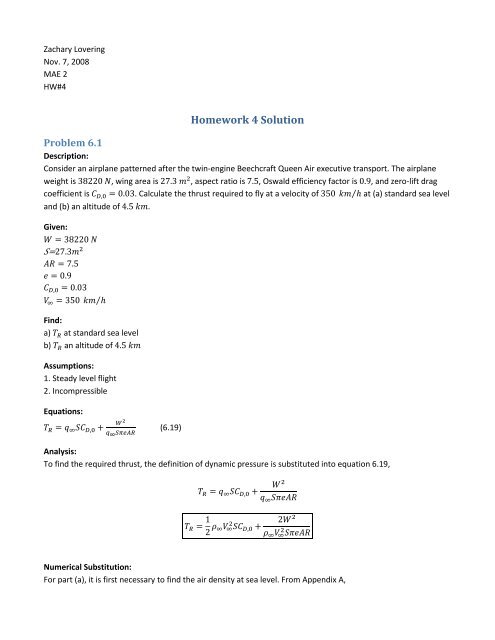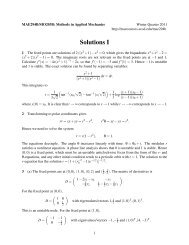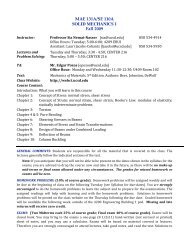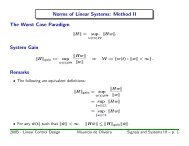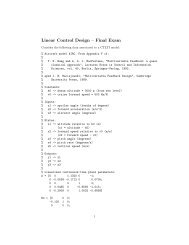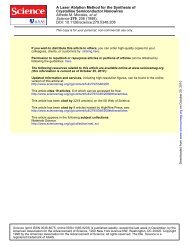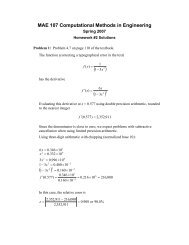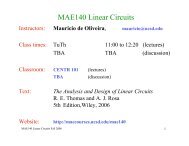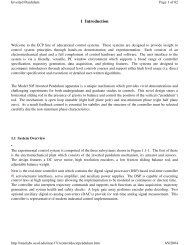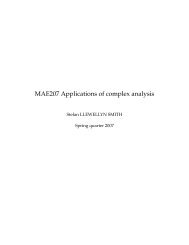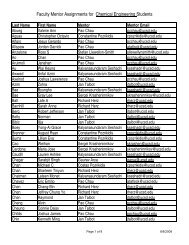You also want an ePaper? Increase the reach of your titles
YUMPU automatically turns print PDFs into web optimized ePapers that Google loves.
Zachary Lovering<br />
Nov. 7, 2008<br />
MAE 2<br />
HW#4<br />
Homework 4 <strong>Solution</strong><br />
Problem 6.1<br />
Description:<br />
Consider an airplane patterned after the twin-engine Beechcraft Queen Air executive transport. The airplane<br />
weight is 38220 , wing area is 27.3 , aspect ratio is 7.5, Oswald efficiency factor is 0.9, and zero-lift drag<br />
coefficient is , 0.03. Calculate the thrust required to fly at a velocity of 350 ⁄ at (a) standard sea level<br />
and (b) an altitude of 4.5 .<br />
Given:<br />
38220 <br />
27.3 7.5<br />
0.9<br />
, 0.03<br />
350 ⁄ <br />
Find:<br />
a) at standard sea level<br />
b) an altitude of 4.5 <br />
Assumptions:<br />
1. Steady level flight<br />
2. Incompressible<br />
Equations:<br />
, <br />
<br />
(6.19)<br />
Analysis:<br />
To find the required thrust, the definition of dynamic pressure is substituted into equation 6.19,<br />
<br />
, <br />
2 <br />
1<br />
2 <br />
, <br />
<br />
<br />
Numerical Substitution:<br />
For part (a), it is first necessary to find the air density at sea level. From Appendix A,
1.2250 <br />
<br />
Additionally, must be represented in consistent units,<br />
350 <br />
1000<br />
1<br />
<br />
1 3600 <br />
97.2 <br />
<br />
Using the equation derived in the analysis, the required thrust is given by,<br />
Note that,<br />
1 <br />
1.2250<br />
2 97.2<br />
<br />
<br />
· <br />
<br />
4739.4 436.04<br />
· <br />
5175.4 <br />
27.3 0.03 <br />
1 1<br />
238220 <br />
1.2250 <br />
97.2<br />
27.30.97.5 · <br />
<br />
For part (b), it is first necessary to find the air density at 4.5 . From Appendix A,<br />
0.77704 <br />
<br />
Using the equation derived in the analysis, the required thrust is given by,<br />
1<br />
<br />
0.77704<br />
2 97.2<br />
<br />
<br />
· <br />
<br />
3006.3 687.42<br />
· <br />
3693.7 <br />
27.3 0.03 <br />
238220 <br />
0.77704 <br />
97.2<br />
27.30.97.5
Problem 6.2<br />
Description:<br />
An airplane weighing 5000 is flying at standard sea level with a velocity of 200 ⁄ .<br />
At this velocity the<br />
⁄ ratio is a maximum. The wing area and aspect ratio are 200 and 8.5, respectively. The Oswald<br />
efficiency factor is 0.93. Calculate the total drag on the airplane.<br />
Given:<br />
5000 200 ⁄ <br />
200 8.5<br />
0.93<br />
Find:<br />
Total drag, <br />
Assumptions:<br />
1. Steady level flight<br />
2. Incompressible<br />
3. Sea level standard air<br />
4. Flying at maximum ⁄ <br />
Equations:<br />
, <br />
<br />
(6.1c)<br />
(5.17)<br />
(5.20)<br />
Analysis:<br />
For a complete airplane, the drag coefficient, , is given by<br />
As noted on pg. 461, when flying at maximum ⁄ ,<br />
Hence,<br />
, <br />
<br />
, , <br />
2 <br />
<br />
<br />
Substituting this equation into the equation for drag for the entire plane yields,<br />
<br />
2
Since the aircraft is in steady level flight . The equation for the lift coefficient, , is given by,<br />
Substituting this equation into the drag equation,<br />
<br />
<br />
<br />
<br />
2 <br />
<br />
<br />
<br />
<br />
2<br />
Substituting in the definition of dynamic pressure, , yields<br />
<br />
2 <br />
1<br />
2 <br />
4 <br />
<br />
<br />
<br />
Numerical Substitution:<br />
It is first necessary to find the air density at sea level. From Appendix B,<br />
0.0023769 <br />
<br />
Additionally, must be represented in consistent units,<br />
200 <br />
<br />
293.3 <br />
<br />
1 <br />
5280 <br />
1 3600 <br />
Using the equation derived in the analysis, the total drag is given by,<br />
Note that,<br />
45000 <br />
<br />
0.938.5 0.0023769 <br />
293.3<br />
<br />
<br />
200 <br />
98.47<br />
· <br />
98.5 1 1<br />
·
Problem 6.4<br />
Description:<br />
Consider an airplane patterned after the Beechcraft Bonanza V-tailed, single-engine light private airplane. The<br />
characteristics of the airplane are as follows: 6.2, 181 , 0.91, 3000 , , 0.027.<br />
The airplane is powered by a single piston engine of 345 maximum at sea level. Assume the power of the<br />
engine is proportional to the free-stream density. The two-blade propeller has an efficiency of 0.83.<br />
a) Calculate the power required at sea level<br />
b) Calculate the maximum velocity at sea level<br />
c) Calculate the power required at 12000 altitude<br />
d) Calculate the maximum velocity at 12000 altitude<br />
Given:<br />
6.2<br />
181 <br />
0.91<br />
3000 <br />
, 0.027<br />
345 hp<br />
0.83<br />
Find:<br />
a) at sea level<br />
b) at sea level<br />
c) , at 12000 <br />
d) at 12000 <br />
Assumptions:<br />
1. Steady level flight<br />
2. Standard air<br />
3. Incompressible<br />
Equations:<br />
(6.24)<br />
<br />
<br />
<br />
, <br />
<br />
<br />
(Required thrust from Prob. 6.1)<br />
(6.31)<br />
, , <br />
/<br />
<br />
/<br />
Analysis:<br />
(6.39)<br />
(6.38)<br />
On pg. 419 it is stated that, “the condition that holds at minimum power required is , <br />
,.” Using this<br />
relation, the minimum power flight velocity may be calculated as follows:
, 1<br />
3 ,<br />
, <br />
3<br />
3,<br />
2<br />
<br />
<br />
<br />
3 ,<br />
4 <br />
<br />
3 <br />
, <br />
4 <br />
<br />
3 <br />
, <br />
Note that this problem did not specifically ask for the minimum power required at sea level. Hence, other<br />
selected values of velocity can be selected and will yield different power requirements. These will be plotted in<br />
the Numerical Substitution section. The required power is given by,<br />
<br />
Substituting the equation derived in Problem 6.1 for the required thrust, , into this equation for required<br />
power yields,<br />
2 <br />
/<br />
1<br />
2 <br />
, <br />
The maximum velocity, , will occur when the aircraft it at full power. The maximum power available is given<br />
by,<br />
<br />
This equation can be substituted into the equation for the required power, , and then solved for . However,<br />
the resulting equation is a fourth-order polynomial and, although closed-form solutions to this problem do exist,<br />
the simplest way to solve this problem is by graphical means. This will be done in the Numerical Substitution<br />
section. Finally, to find the required power and corresponding velocity at a different altitude, the following<br />
equations are used:<br />
, , <br />
/<br />
<br />
/<br />
where , is the required power at sea level, which we found in part (a), is the sea level air density, and is<br />
the maximum velocity at sea level. To solve for the maximum velocity at a different altitude, the available power<br />
must first be adjusted. It is given that the power available is proportional to the air density and so the following<br />
equation must hold:
, , <br />
<br />
As stated in part (b), the maximum velocity corresponding to this maximum power will be determined<br />
graphically.<br />
Numerical Substitution:<br />
To find the power required at sea level, it is required to know the air density at sea level. From Appendix B, the<br />
sea level standard air density is<br />
0.0023769 <br />
<br />
Using the required power equation and the maximum and minimum power equations, the following graph was<br />
produced:<br />
Power Required [HP]<br />
400<br />
350<br />
300<br />
250<br />
200<br />
150<br />
100<br />
50<br />
0<br />
Sea Level Power Required vs. Velocity<br />
0 50 100 150 200 250 300 350<br />
Velocity [ft/s]<br />
Power Required Maximum Velocity Minimum Power<br />
For part (a), acceptable answers for required power lie on the “Power Required” curve. To find the minimum<br />
power, the velocity at minimum power equation is used.<br />
<br />
43000 <br />
<br />
<br />
<br />
<br />
30.91 6.20.027 0.0023769 <br />
<br />
<br />
<br />
<br />
181 <br />
<br />
<br />
<br />
<br />
220<br />
192.5<br />
165<br />
137.5<br />
110<br />
82.5<br />
55<br />
27.5<br />
0<br />
Power Required [1000 lbf * ft/s]
36000000 <br />
0.26573 <br />
<br />
36000000<br />
0.26573<br />
36000000<br />
0.26573<br />
107.9 <br />
<br />
<br />
<br />
<br />
<br />
<br />
<br />
<br />
<br />
As can be seen, this result for agrees with the “Sea Level Power Required vs. Velocity” graph. Using this<br />
velocity, the minimum power required is given by,<br />
<br />
<br />
1<br />
<br />
0.0023769 107.9<br />
2 <br />
<br />
1810.027 23000 <br />
<br />
<br />
0.0023769 <br />
107.9<br />
1810.91 6.2<br />
· <br />
7296<br />
<br />
21877 · <br />
<br />
7296 · <br />
21877 · <br />
· <br />
29173 · <br />
<br />
The required power can also be represented in hp as follows:<br />
29173 · <br />
<br />
53.04 hp<br />
<br />
1 hp<br />
550 · <br />
<br />
As can be seen, this result for agrees with the “Sea Level Power Required vs. Velocity” graph. This concludes<br />
that answer to part (a). In part (b), it is required to find the maximum velocity. To do so, it is first necessary to<br />
find the maximum power available.<br />
0.83345 hp<br />
286.35 hp<br />
Using the graph, this maximum power at sea level corresponds to
295 <br />
<br />
This value is represented by the “maximum velocity” line on the graph. For part (c), a new plot can be created to<br />
adjust for the density difference at 12000 altitude. The air density at 12000 can be found in Appendix B.<br />
0.0016480 <br />
<br />
Answers for required power lie on the “Power Required” curve in the graph below.<br />
Power Required [HP]<br />
300<br />
250<br />
200<br />
150<br />
100<br />
50<br />
0<br />
12,000 ft Altitude Power Required vs. Velocity<br />
0 50 100 150 200 250 300 350<br />
Velocity [ft/s]<br />
Maximum Power Maximum Velocity Minimum Power<br />
The minimum power required can be solved as in part (a) or can be solved graphically. Additionally, the density<br />
change can be accounted for as follows:<br />
0.0023769<br />
<br />
<br />
0.0016480 <br />
<br />
107.9 <br />
1.201<br />
<br />
129.6 <br />
<br />
107.9 <br />
<br />
Similarly, the corresponding minimum power at altitude is,<br />
<br />
<br />
165<br />
137.5<br />
110<br />
82.5<br />
55<br />
27.5<br />
0<br />
Power Required [1000 lbf * ft/s]
, 29173 · <br />
<br />
35035 · <br />
<br />
<br />
<br />
0.0023769<br />
<br />
<br />
0.0016480 <br />
<br />
63.70 hp<br />
Since the engine output power is proportional to the air density, the power available must also be adjusted.<br />
0.0016480<br />
, 286.35 hp <br />
<br />
0.0023769 <br />
<br />
, 286.35 hp0.6933<br />
, 198.54 hp<br />
Using the graph, this maximum power at 12000 corresponds to<br />
289
Problem 6.25<br />
Description:<br />
The Predator UAV has the following characteristics: 14.85 , 11.45 , 1020 , <br />
295 . The power plant is a Rotax four-cylinder, four-stroke engine of 85 hp driving a two-blade, variable-<br />
pitch pusher propeller. Assume 0.7, , 0.03, 0.9, and the 0.2 · ⁄ hp.<br />
Calculate the<br />
maximum velocity of the Predator at sea level.<br />
Given:<br />
14.85 <br />
11.45 <br />
1020 <br />
295 85 hp<br />
0.7<br />
, 0.03<br />
0.9<br />
0.2 · ⁄ hp<br />
Find:<br />
<br />
Assumptions:<br />
1. Sea level standard air<br />
2. Incompressible<br />
3. Steady level flight<br />
Equations:<br />
(6.31)<br />
<br />
<br />
, <br />
<br />
<br />
(6.29)<br />
Analysis:<br />
The maximum velocity occurs when using maximum available power. To find the maximum available power, the<br />
following equation is used:<br />
<br />
This equation is substituted into the required power equation.<br />
2 <br />
1<br />
2 <br />
, <br />
Finally, the definition of the aspect ratio is substituted in as follows:<br />
1<br />
2 <br />
, <br />
2 <br />
⁄
1<br />
2 <br />
, <br />
2 <br />
<br />
This equation must be solved for . However, as noted in Problem 6.4, this equation is a fourth-order<br />
polynomial and, although closed-form solutions to this problem do exist, the simplest way to solve this problem<br />
is by graphical means or by iteration. The method of solving graphically was illustrated in Problem 6.4 and so the<br />
method of iteration will be demonstrated in the Numerical Substitution section of this problem.<br />
Numerical Substitution:<br />
To begin, it is first required to find the density at sea level. From Appendix A, the sea level standard air density is<br />
Next, will be converted into consistent SI units.<br />
1.225 <br />
<br />
9.8 <br />
1020 <br />
1 9996 <br />
Similarly, the power, , must also be converted into consistent SI units.<br />
Using the equation derived in the analysis,<br />
746 W<br />
85 hp <br />
1 hp <br />
63410 <br />
0.963410 1 <br />
1.225<br />
2 11.450.03<br />
<br />
57069 0.2104 <br />
<br />
33.65 <br />
57069 0.2104 <br />
33.65<br />
0.2104 <br />
<br />
33.65 · <br />
<br />
<br />
<br />
· <br />
<br />
57069 0<br />
29996 <br />
1.225 <br />
14.85 0.7<br />
First, note that the units are consistent. In other words, for the first term on the left hand side,<br />
For the second term on the left hand side,<br />
<br />
<br />
<br />
· <br />
<br />
· <br />
<br />
<br />
· <br />
<br />
<br />
<br />
· <br />
<br />
·
To solve this equation iteratively, first guess a value for , then calculate the left hand side. If it is equal to<br />
zero then you have the correct value. Otherwise, guess a new and calculate the left hand side again. This<br />
process is most easily done using a program like Excel since it is easy to store and solve an equation.<br />
Alternatively, many calculators or programs such as Matlab have built in solvers. The solution by any of these<br />
means will yield,<br />
64.73


